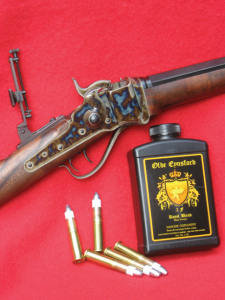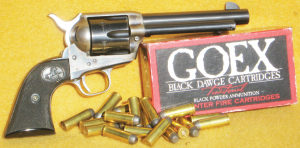by Mike Nesbitt | Contributing Editor

Olde Eynsford is shown with the author’s new C. Sharps Arms Model 1874 .44/77 rifle and loads using the new powder.
Olde Eynsford is a brand new match grade blackpowder introduced by GOEX and this powder can really be blazing new trails for old blackpowder shooters. So far I’ve done only a little shooting with this new powder, so an introduction is just about all I can give you at this time. Even so, the performance I’ve seen with Olde Eynsford is outstanding enough that I want to get the word out as soon as possible.
One point needs to be mentioned right away, Olde Eynsford is made with some slightly different ingredients that the regular “red can” GOEX line of the “F” series powders. What those differences actually are I don’t know. But I do know that when compared volume to volume the Olde Eynsford is noticeably lighter in weight than with corresponding F-series powders. So, when I mention powder charges with Olde Eynsford I will specify either “by volume” or “by weight.” In general, my powder charges with Olde Eynsford will use the same volumes as with the F series powders and that simply means a pound of Olde Eynsford will go a bit farther by offering just a couple of more shots.
Olde Eynsford powder comes in three granulations; 1½F, 2F and 3F. Please notice that it is not identified as an “Fg” powder which should mean that Olde Eynsford is not graphite coated. And is truly a real blackpowder, not a substitute. There was some question about it being a real blackpowder because it seems to produce less smoke and is certainly leaves less fouling in the barrel. To answer any questions about it being a blackpowder or not, GOEX sent out a statement verifying that Olde Eynsford is truly a blackpowder. And, as such, it is classified as a Class A explosive.
The grade of Olde Eynsford that I did most of my shooting with is of the 2F granulation. This powder was immediately tried in my .54 caliber flintlock Leman, the rifle I call Tacky Too. My reason for shooting it in a flintlock first was simply to be able to say that it ignites very well in a flint gun, like a true blackpowder should. The rifle’s pan was primed with GOEX FFFFg, as usual, and ignition for all of my shots was very good.
For this initial shooting test with Olde Eynsford only one powder charge was used, 60 grains by volume. Five shots were fired at a bullseye target which was posted at 25 yards. The group on that target was a bit high and the velocity was also higher than what my rifle is used to, so the higher impact of the .526” ball did not surprise me.
Velocity was checked over the chronograph and the average speed for the five shots I tested was 1,342 feet per second (fps) with an extreme spread in the velocities of 51 fps. That compares favorably to some shooting I had done with this same rifle using 60 grains of GOEX FFg which had an average velocity of 1,218 feet per second with an extreme spread of 50 fps. The Olde Eynsford will show velocity increases in other guns as well.
Next the Olde Eynsford 2F was tried in a new rifle (one that I do believe you’ll be seeing again on these pages), a custom .44/77 by C. Sharps Arms. This rifle is a real beauty but I will try to keep focused on the new powder. When using 75 grains (by volume) of the Olde Eynsford 2F under a 400-grain paperpatched bullet the average velocity from the Sharps’ 28-inch long barrel was 1,358 fps. That velocity is very respectable for a blackpowder cartridge.
While I don’t have any data to compare it with while using FFg, I can tell you that 75 grains of KIK 1.5Fg powder (again measured by volume) produces an average velocity of 1,316 while using the same paper patched bullet out of this rifle.
Velocity, of course, is only one characteristic. Other points to consider for a blackpowder, in addition to velocity and accuracy, are cleanliness of burning and fouling deposits in the barrel. Olde Eynsford burns so cleanly and with a reduced amount of smoke, enough that some shooters trying this new powder suspected it to be a blackpowder substitute. But no, it is a genuine blackpowder and statements from GOEX bear that out. (That is also why I tried it in a flintlock first, if it wasn’t blackpowder it probably wouldn’t work.) I will say that the Olde Eynsford burns cleanly enough that cleaning the fired cases is much easier. Some have actually said that cleaning the brass cartridge cases might not be a requirement when using Olde Eynsford. For now I’ll continue to clean my brass but I am enjoying the easier task of it.
Next, some Olde Eynsford was tried in another rifle from C. Sharps Arms, a Model 1874 Hartford style in .50/70 caliber. For this rifle, the stubby .50/70s were loaded with 70 grains of the new powder (by volume) under a 480-grain paper patched bullet. This load produced 1,214 fps average out of the rifle’s 30-inch barrel. I don’t have any data on hand to compare this too but I will say that any load with speeds greater than 1,200 fps in the .50/70 is giving excellent performance.
And some shooting was done with Olde Eynsford 3F powder in a couple of .45 Colt revolvers. I was actually sent some “pre-production” loads in order to help learn about the “workings” of this powder and to recommend future loadings. In this case the powder was measured by weight, 33 grains, and it was loaded by Black Dawge Cartridges, makers of blackpowder ammunition.
Black Dawge loaded the 33 grains of 3F under a 235-grain flat nosed bullet for the .45 and that is actually a rather hot load. From the 7½-inch barrel of my old .45 (which I’ve had for over 50 years!) those bullets hurried across the chronograph at 1,021 fps. I’ll say that accuracy was good, but let me explain that I am a bit out of practice with my old .45. Even so, all shots stayed on the paper at 25 yards.
My father’s old .45 with a 5½-inch barrel was also tried and the loads felt just as hot in that gun as they did with the 71/2-inch barrel. The chronograph, however, showed much slower results, so slow that I doubt them and won’t include that data at this time. Shooting the shorter barreled .45 did help me make a conclusion to recommend future loadings of 28 grains with the Olde Eynsford 3F powder. Perhaps a report shall follow. And if you load some .45s with Olde Eynsford yourself, try the lighter powder charge first.
Like with the rifles, the cleanliness of the new powder was easily noticed and highly appreciated. Those .45 Colt empties might get reloaded without cleaning them.
Olde Eynsford is a new blackpowder that we’ll be hearing a lot more about in what should be a rather short time.
Most all shooters who have tried it are very impressed with its performance and cleanliness. When comparing this new powder to other blackpowders, such as the red can GOEX, remember to compare it volume to volume because Olde Eynsford does seem to be a “hotter” powder.
The price for Olde Eynsford powder really isn’t too bad. Powder, Inc.
(powderinc.com) is advertising it at $16 per pound when purchased in a case of 25 pounds. That’s $1.10 per pound more than the “red can” GOEX. I believe Olde Eynsford is the “higher grade” of American made blackpowder that a lot of us have been waiting for and from what I see, it was worth the wait.




